Physical Address
304 North Cardinal St.
Dorchester Center, MA 02124
Endoscopy provides a unique opportunity to visualize the mucosal surface of the gastrointestinal (GI) tract and, through endoscopic imaging techniques, a variety of extraluminal and extraintestinal organs and structures. When considered within the context of a specific clinical picture, endoscopic images may be all that is needed to establish a specific diagnosis or provide sound clinical management. However, endoscopists often must sample tissue and/or obtain specimens for cytology, although optical endomicroscopy methods have rapidly advanced and are now replacing the need for ex vivo microscopy in some situations. Examination by a qualified pathologist of specimens obtained at endoscopy is a routine and critical part of managing disorders of the alimentary tract. The purpose of this chapter is to orient the pathologist to the clinical and technical considerations unique to specimens obtained endoscopically from the alimentary tract and to promote collaboration between endoscopists and pathologists in procurement and processing of tissue samples, and, when appropriate, in endomicroscopy. This is followed by a discussion of the normal anatomy of the tubal gut.
The effectiveness of endoscopy often depends on the quality of the bowel preparation. Preparation of the upper GI tract for endoscopy typically involves, at minimum, a 6-hour fast. Preparation for colonoscopy is achieved by use of oral purging agents, either with or without enemas. Most colonoscopy preparation regimens include the use of a clear liquid or low-residue diet for 1 to 2 days, followed by cleansing with oral polyethylene glycol (PEG)-electrolyte solution or other low-volume, often hypertonic solution combined with water intake. Splitting the dose, or “split prep,” between the evening before and the morning of the procedure has been widely shown to improve preparation quality compared with only evening-before dosing ( Box 1.1 ). In general, vomiting is reported more frequently with oral PEG-based high-volume lavage regimens than with other agents. , PEG lavage regimens reportedly provide more consistent cleansing. ,
48-hr clear liquid diet, 240-mL magnesium citrate PO, senna derivative laxative
48-hr clear liquid diet, senna derivative laxative, rectal enema
24-hr clear liquid diet, 240 mL magnesium citrate PO or 4 L PEG-electrolyte lavage
24-hr clear liquid diet, 2 L PEG-electrolyte lavage, cascara-based laxative
24-hr clear liquid diet, 2 L sodium phosphate electrolyte lavage
Purgative- and laxative-based regimens are more likely to cause flattening of surface epithelial cells, goblet cell depletion, lamina propria edema, mucosal inflammation, and increased crypt cell proliferation, although these effects occur infrequently. Osmotic electrolyte solutions, such as PEG-based solutions, are better agents for preserving mucosal histology. In the most severe form of mucosal damage caused by purgatives such as sodium phosphates, sloughing of the surface epithelium, neutrophilic infiltration of the lamina propria, and hemorrhage may be encountered, and the changes may even resemble pseudomembranous colitis, nonsteroidal antiinflammatory drug–induced injury, or inflammatory bowel disease. , , Oral sodium phosphate bowel preparations were removed from the U.S. market in 2008 after their use was associated with renal injury. Chemical-induced colitis, caused by inadequate cleaning of endoscopic instruments, also has been reported but is very rare. Sodium phosphate–based preparations may also cause endoscopically visible aphthoid-like erosions similar in appearance to Crohn’s disease. Mucosal changes in this situation may also resemble pseudomembranous colitis, both endoscopically and microscopically.
There are a limited number of methods available for obtaining tissue via GI endoscopy. This section describes several of these methods and the common situations in which they are used. A key issue is whether tissue resection is diagnostic or performed for therapeutic or curative intent. Increasingly, endoscopic removal of superficial carcinoma is being performed by endoscopic mucosal resection (EMR) or endoscopic submucosal dissection (ESD). In these cases, definitive pathologic staging (grade, depth-of-invasion, lymphovascular invasion, margin status) are critical.
Pinch biopsy, performed with the use of a biopsy forceps during endoscopy, is the most common form of tissue sampling; the biopsy site is usually fully visualized at the time of sampling. Suction capsule biopsy requires fluoroscopic guidance to position a long tube with the biopsy apparatus and is done separately from endoscopy without visualization. Suction capsule biopsy without bowel visualization is still performed in some centers, but it is less successful than endoscopy-guided biopsy in obtaining tissue and therefore has fallen out of favor. Pinch biopsies may be small or large (the latter are referred to as “jumbo” biopsies) and can be obtained with or without the use of electrocautery. Electrocautery has value for hemostasis and destruction of residual tissue but introduces burn artifact into the harvested tissue.
All standard biopsy forceps have a similar design ( Fig. 1.1 ). The sampling portion consists of a pair of small cups that are in apposition when closed. In this manner, they can be passed through the channel of a gastroscope or colonoscope. Some biopsy forceps have a spike at the base of the cup or teeth to help seat the forceps against the mucosa. The spike also helps impale multiple biopsy specimens before the forceps are removed from the endoscope.
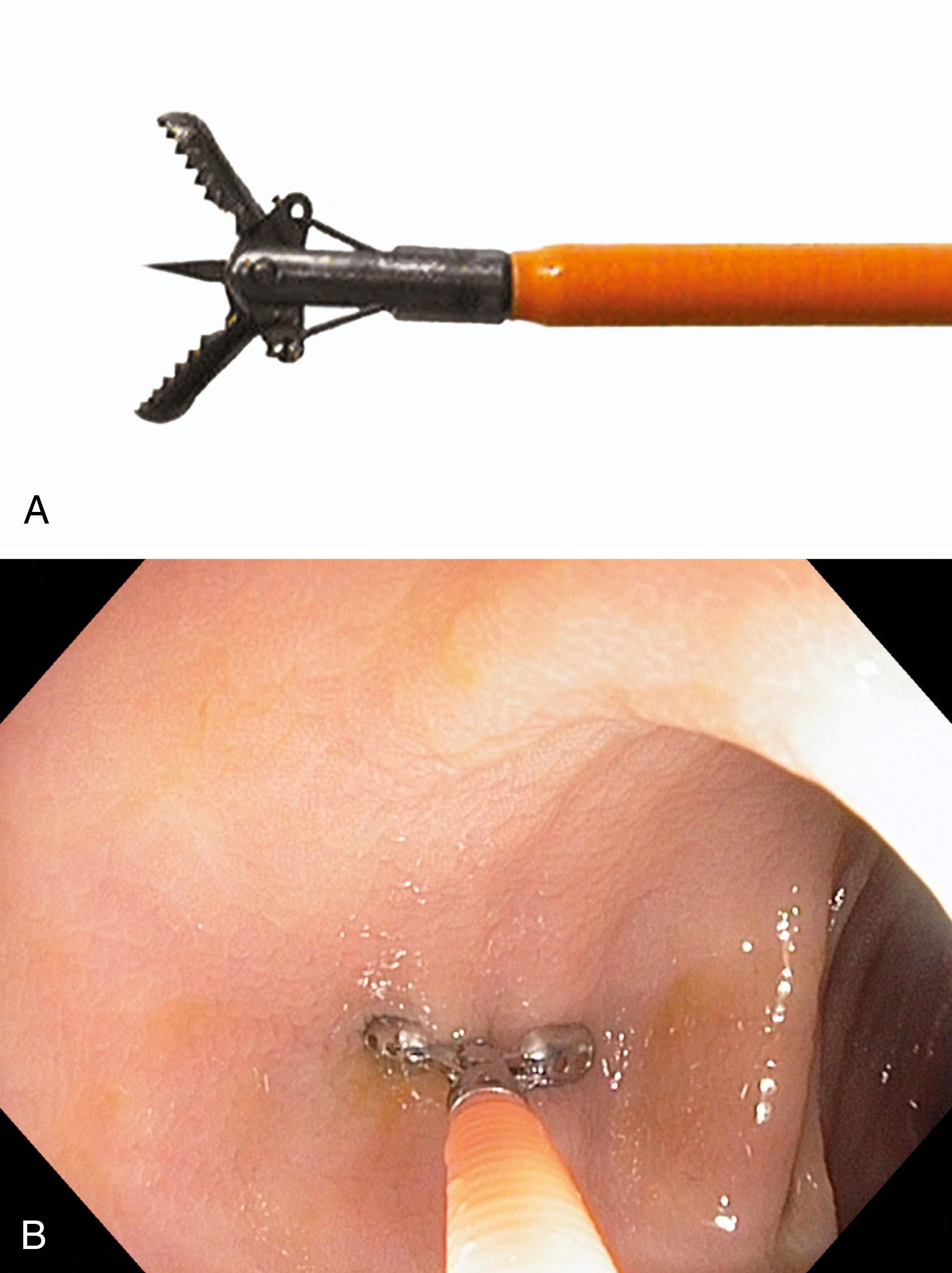
After insertion into the endoscope and emergence from the distal end, routine biopsy forceps can be opened to a 4- to 8-mm width. The opened forceps are pressed against the mucosal surface for tissue sampling. Large-cup (jumbo) biopsy forceps have jaws that open to a width of 7 to 9 mm. The biopsy forceps are closed against the mucosal surface, and the endoscopist pulls the forceps away from the mucosa to remove the fragment of tissue. This method often yields samples that include muscularis mucosae, except in regions such as the gastric body, where the mucosal folds are quite thick. The submucosa is sampled occasionally with either standard or jumbo forceps.
The sample size varies according to the amount of pressure the endoscopist applies to the forceps. In addition, application of a fully opened biopsy forceps flush against the mucosa before closure usually yields larger pieces of tissue, compared with tissue obtained by tangential sampling or incomplete opening of the forceps. In general, biopsy specimens are 4 to 8 mm in length. , The forceps shape does not impart a significant difference in either size or adequacy of biopsy specimens. While reusable biopsy forceps retain their ability to generate satisfactory biopsies through many uses, , single-use disposable biopsy forceps also have been shown to provide excellent samples. In essence, there are no differences in the quality of tissue samples obtained among the dozen or more biopsy forceps currently available, so the primary considerations in the selection of an endoscopic biopsy forceps are usually related to cost.
After the biopsy specimens have been obtained and the forceps have been removed from the endoscope, an assistant dislodges the tissue fragments from the forceps with a toothpick or a similar small, sharp instrument. The tissue is then placed into a container with appropriate fixative and labeled according to instructions provided by the endoscopist.
Specimens obtained with a jumbo forceps often exceed 6 mm in maximum diameter, but these are not necessarily deeper than standard biopsies. Rather, a jumbo forceps typically provides more mucosa for analysis. This is particularly useful during surveillance tissue sampling, such as in patients with Barrett’s esophagus or ulcerative colitis. Jumbo biopsy forceps are as safe as standard biopsy forceps. However, the use of jumbo forceps is limited by their diameter because the instrument cannot fit through a standard endoscope accessory channel. Jumbo forceps require a 3.2-mm–diameter channel, characteristic of therapeutic endoscopes, which may be less comfortable for patients. In addition, although jumbo biopsy specimens are larger than standard biopsy specimens, this does not necessarily mean that they are of greater diagnostic value.
Upper endoscopy or colonoscopy may be performed for clinical indications driven by symptomatology. Colonoscopy, in particular, may also be performed for screening purposes in clinically asymptomatic individuals. Selection of a biopsy site at the time of endoscopy is driven by the need to assess visible mucosal abnormalities. In addition, it is advantageous to establish the inflammatory status of the “background” mucosa by sampling normal-appearing mucosa during the evaluation of conditions such as gastroesophageal reflux disease (GERD), nonulcer dyspepsia, diarrhea, polyps, and nodules and for surveillance of premalignant conditions, including Barrett’s esophagus and inflammatory bowel disease. For example, in patients with inflammatory or dysplastic polyps of the stomach, it is essential to sample adjacent nonpolypoid mucosa to help determine the background disorder in the stomach in which the polyp has developed. As a second example, the ampulla of Vater may be biopsied to exclude adenomatous change in patients with familial adenomatous polyposis because the lifetime incidence of ampullary adenomas in these patients exceeds 50%.
Biopsy of biliary or pancreatic strictures may be carried out under fluoroscopic guidance during endoscopic retrograde cholangiopancreatography (ERCP) with the use of either standard or specially designed biopsy forceps. Even gallbladder lesions observed on ERCP may be amenable to endoscopic biopsy, although this is rarely performed clinically. Endoscopy-directed diagnostic biopsies are extremely safe. In one study of 50,833 consecutive patients who underwent upper endoscopy, none had any biopsy-associated complications. The risk of perforation after diagnostic or therapeutic colonoscopy (with polypectomy) is extremely low.
Occasionally, an endoscopist uses a specialized insulated biopsy forceps to sample a small polyp (“hot biopsy”), after which remaining tissue is ablated in situ using electrocautery. Unfortunately, cautery artifact in such small tissue samples often makes histologic interpretation difficult (or impossible). , In addition, the electrocautery technique carries an excessive risk of perforation resulting from deep tissue burn, particularly in the cecum and ascending colon. , Finally, destruction of residual dysplastic tissue by electrocautery may be incomplete in as many as 17% of cases. For these reasons, hot biopsies have been largely abandoned by most endoscopists. A rare exception to this is a technique called “hot avulsion,” which is used to resect fibrotic tissue within a larger adenoma of the colon. This typically occurs when prior attempts at resection or tattooing have caused fibrosis. Special high-energy cutting electrosurgical currents are used in combination with hot biopsy forceps to preserve tissue architecture and minimize thermal injury.
There is now substantial literature available regarding the approach of the “resect and discard” concept for diminutive colorectal polyps found during screening colonoscopy. This concept suggests that one can safely perform endoscopic removal of diminutive colon polyps (usually by simple pinch biopsy removal using cold forceps or cold snare polypectomy) without the need for pathologic analysis of the polyp. The reasoning is that diminutive polyps have a very low likelihood of harboring either malignancy or advanced adenomatous features such as high-grade dysplasia or villiform change. Therefore discarding these lesions without histologic evaluation should be cost-effective and clinically efficacious, with an endoscopic sensitivity for correctly classifying adenomas of 94% and a specificity of 89%. Furthermore, these polyps may be assessed by in situ optical scanning techniques that can help predict polyp histology. For instance, narrow band imaging and other similar image-enhanced methods have a reported negative predictive value of 95%, which further increases physician confidence that the polyps can be discarded without pathologic examination. A recent comprehensive review of the literature by the American Society for Gastrointestinal Endoscopy suggests that prespecified accuracy thresholds have been met in specific circumstances. In this setting, a resect and discard (along with nonremoval of diminutive rectosigmoid hyperplastic polyps) is acceptable. However, the success of applying such endoscopic criteria for optical diagnosis only remains an open question because successful optical identification of adenomas may not be achieved in routine clinical practice outside of academic medical centers.
Diminutive polyps may be sampled by pinch biopsy at the time of upper endoscopy or colonoscopy. Polyps larger than 0.5 cm are amenable to snare polypectomy, although the size of the polyp that can be excised may be limited by the size of the loop placed around it (and the endoscopist’s estimation of perforation risk). During endoscopy, a loop of wire is placed around a polypoid lesion that protrudes into the lumen of the gut for the purpose of removing the polyp ( Fig. 1.2 ). This technique is used primarily for colonic polyps, but polyps throughout the alimentary tract may be excised in this manner.
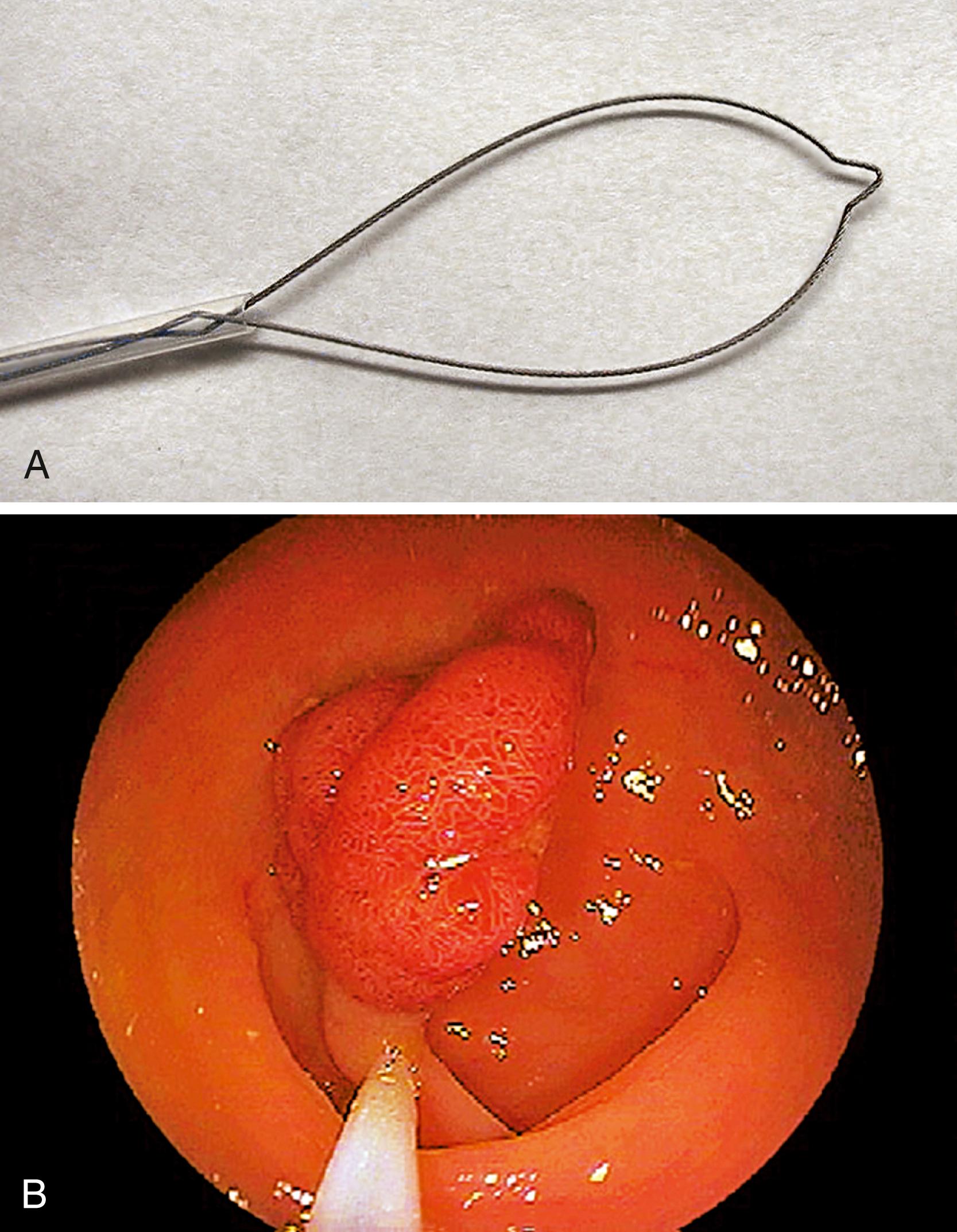
Alternatively, large polyps can be removed in a piecemeal fashion and submitted to pathology in several parts. This technique usually requires multiple transections of the lesion until the entire polyp has been removed. One caveat with the latter technique is that identifiable tissue margins may be lost, so the pathologist is often unable to determine the status of the resection margins.
Snares are available in a variety of shapes and sizes. Some snares can be rotated, which provides the endoscopist with greater control of snare placement. The choice of snare size is usually based on the size of the lesion being removed. The selection of a particular snare shape is a matter of personal choice. Snare polypectomy is performed in a similar fashion regardless of whether colonic, esophageal, gastric, or small bowel lesions are being removed. The ampulla of Vater may be resected by standard snare techniques if an ampullary lesion is discovered. Depending on their size, excised polyps are either retrieved through the suction channel of the endoscope or held by the snare after resection while the colonoscope is removed from the patient.
Historically, snare polypectomy was only rarely performed without electrical current (i.e., cold polypectomy); however, this is now growing rapidly as data suggest that it is of similar efficacy and lower risk. The cold method tends to remove a wider margin of tissue and also a more superficial depth of tissue, but both are highly effective for complete polypectomy. Many endoscopists have reported successful removal of diminutive polyps (<0.5 cm in diameter) during both “hot” (with electrocautery) and “cold” (without electrocautery) snare polypectomy, , although cold polypectomy may be preferred because of the absence of cautery artefact in the resected small tissue specimens. These endoscopists use small metal snares, termed mini-snares, that open to a size of either 1 to 2 cm or 2 to 3 cm.
A hot snare allows the endoscopist to apply modulated electrosurgical current to a metal wire that cuts through pedunculated polyps at the base. This assists tissue cutting and coagulation. Electrocautery also minimizes bleeding from larger blood vessels that are characteristically located in the stalk of a pedunculated polyp. Information on the relative risk of clinically significant hemorrhage after hot polypectomy is limited, but the risk is generally considered to be low (0.4%). , A higher risk of postpolypectomy hemorrhage occurs in patients with pedunculated polyps larger than 1.7 cm or a stalk diameter larger than 0.5 cm, sessile polyps, or malignant lesions. , cold polypectomy (without electrical current) avoids the use of cautery and thereby limits the amount of burn artifact in the specimen and minimizes the risk of perforation. Postprocedure bleeding may actually be less following cold snare polypectomy, possibly because the electrocautery may damage the large vessels and hence impede hemostasis. For smaller polyps (<10 mm), there appears to be no difference in postprocedure bleeding from hot versus cold polypectomy. ,
In general, the risk of perforation from either mechanical or electrical injury is minimal but is greater in portions of the colon that are covered by a free serosal surface, such as the transverse colon. The risk of perforation during snare polypectomy is less than 0.1%, , and perforation usually results from transmural burn secondary to cautery. One commonly used technique aimed at decreasing the risk of perforation is to pull the snared polyp away from the mucosa so less cautery is applied to the underlying tissue.
For polyps excised in one piece by either hot or cold polypectomy, the polyp base constitutes the surgical margin of resection. This is true for both pedunculated and sessile polyps. For polyps removed by hot snare polypectomy, the cauterized portion of the specimen constitutes the surgical margin. An artificial stalk can be created when large sessile lesions are loop-excised. A true pedunculated polyp, with a stalk, has a narrow base that persists after removal; the base of a sessile polyp is typically as wide as the mucosal surface that is sampled.
Another commonly used method is saline-assisted polypectomy. , A small needle is passed through the endoscope and inserted into the gut wall adjacent to the polyp. A bolus of normal saline is then injected. Fluid collects within the submucosal plane, lifting the mucosal-based polyp away from the muscularis propria. A standard snare polypectomy is then performed, but the cushion of saline insulates the deeper tissue layers from the electrical current. Saline-assisted polypectomy is usually reserved for large sessile polyps and ampullary polyps and, theoretically, results in a decreased rate of polypectomy-associated perforation.
The use of a liquid cushion to expand the submucosa and minimize transmural cautery damage is a principal feature of EMR. This technique is commonly used to resect premalignant and malignant lesions confined to the mucosa. In general, EMR requires some measure of confidence that a lesion is, in fact, confined to the mucosa or submucosa. Historically, endoscopists relied on endoscopic ultrasonography (EUS) to determine the depth of a particular lesion before EMR. However, this has not been shown to provide high accuracy. Typically, endoscopists attempt to distinguish between lesions that are noninvasive (no submucosal invasion), superficially invasive (typically < 500 to 1000 microns below the submucosa), and deeply invasive (>1000 microns into the submucosa). Standard polypectomy or piecemeal EMR is sufficient for noninvasive lesions, and ESD is preferred to assess depth and margin status for superficially invasive lesions.
Several variations of the EMR technique are currently used. Many rely on submucosal injection of liquid, but there is no agreement regarding the type or quantity of liquid that should be injected ; recent evidence suggests that viscous agents improve resection efficiency. There is general agreement that the selected lesion should appear, endoscopically, to be raised by the cushion of liquid before the EMR is performed. Failure to lift the lesion despite generous use of submucosal saline (the so-called nonlifting sign ) may be a sensitive indicator that a lesion has invaded into the muscularis propria or deeper into the bowel wall.
The most common cap-assisted EMR technique is similar to variceal band ligation but is followed by snare resection of the pseudopolyp created by the band. This is known as band-ligation EMR ( Fig. 1.3 ) and is most commonly used in Barrett’s esophagus–associated neoplasia.
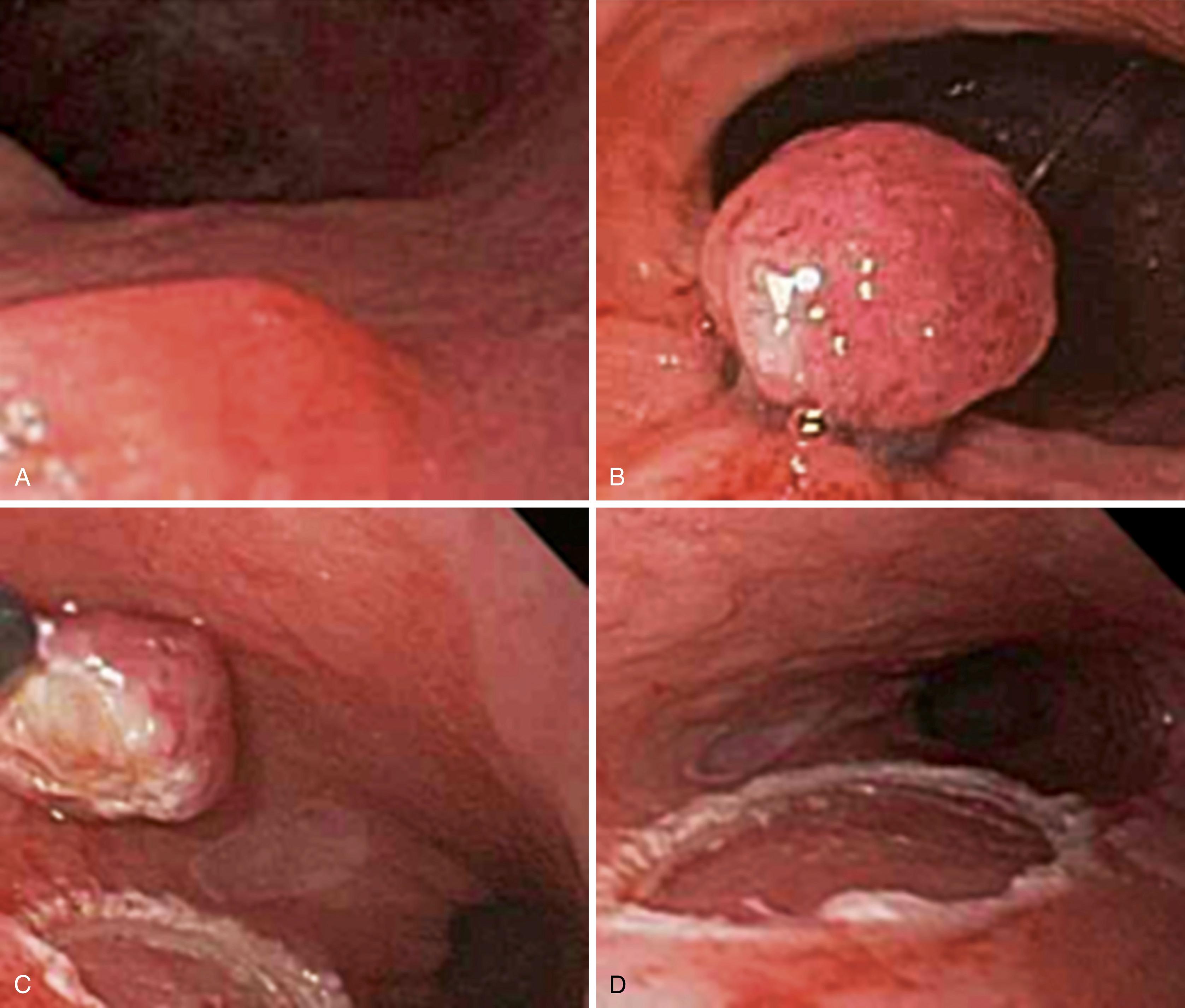
EMR allows the endoscopist to attempt an en bloc resection and thus, potentially, to completely resect an early malignant lesion. En bloc resection is limited, however, to small lesions (1.5 to 2 cm in largest diameter). If deep margins are positive for neoplasia, surgical resection of the affected region is advocated. Current indications for EMR include superficial carcinoma of the esophagus or stomach in patients who are not candidates for surgery; unifocal high-grade (or low-grade) dysplasia in Barrett’s esophagus; and large, flat colorectal adenomas (which may otherwise require piecemeal resection), regardless of the degree of dysplasia. EMR as a form of primary therapy for small, superficial cancers has gained increasing popularity in the United States and Europe because of its high level of efficacy and safety. EMR is also used as a form of primary therapy for small submucosal lesions such as rectal well-differentiated neuroendocrine tumors (carcinoid) or leiomyomas. In many cases, the submucosal lesion can be completely resected ( Fig. 1.4 ).
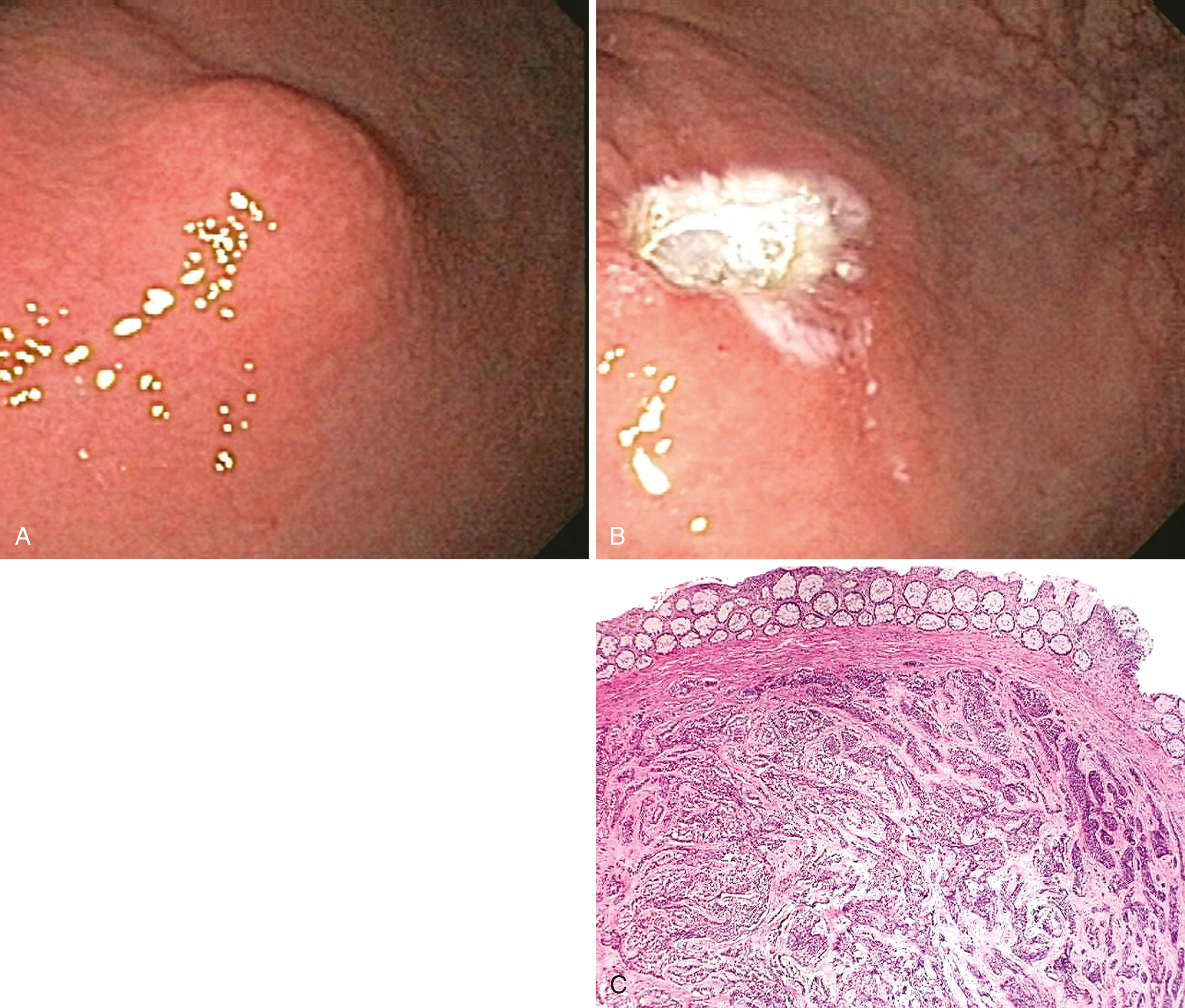
Major complications of EMR include bleeding and perforation. Bleeding occurs in fewer than 20% of cases, depending on the size of the lesion and its location, but is typically managed conservatively, or rarely with repeat endoscopy and coagulation. , Perforation rates are lower than 2% in the hands of experienced operators. A recent recommendation is that the endoscopist should immediately inspect the underside of the resected specimen for the presence of a “target sign” ( Fig. 1.5 ), a pale ring of muscularis mucosa resected with the mucosal lesion. Applying endoscopic clips to the corresponding defect in the resection site is purported to represent an effective method to mitigate the risk of postprocedure bleeding. In the hands of experienced operators, EMR results in large specimens for pathologic analysis, even in the absence of complete resection. Success rates for resection of larger lateral spreading colonic adenomas by EMR approximates 98%, greatly reducing the need for surgical resection.
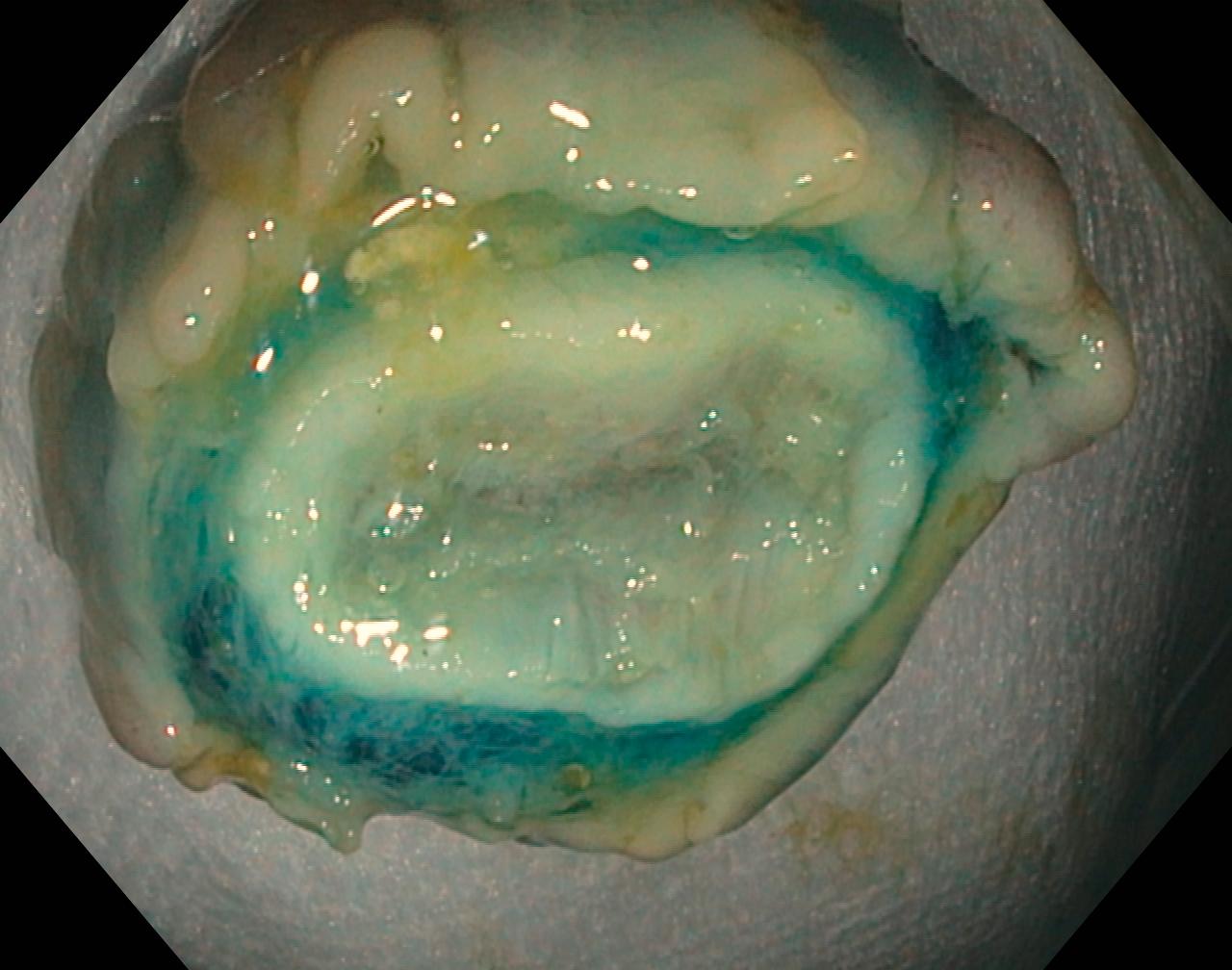
ESD is a more advanced method of resection of GI neoplasia. It allows for en bloc resection of lesions larger than 2 cm, thus allowing precise deep and lateral margin assessment and precise histologic assessment of depth of invasion. Like EMR, the technique involves submucosal injection of a lifting agent, but is followed by circumferential incision of the mucosa 5 to 10 mm outside of the lesion margins, and then endoscopic dissection through the submucosa to fully separate the lesion. This method requires special electrosurgical knives, and it is more technically demanding and time-consuming than EMR. Recent European guidelines (U.S. guidelines are not currently available) suggest that ESD is preferred for cancers or suspected cancers limited to the superficial submucosa. Because of variability in lymphatic spread from different organs, current guidelines suggest that esophageal cancers limited to 500 microns or less submucosal invasion, and gastric/colonic cancers limited to 1000 microns invasion are considered potentially curative by ESD. Other factors include histologic features that increase the likelihood of lymphatic/distant spread such as poor differentiation, lymphovascular invasion, and tumor budding. For this reason, it is essential that endoscopists and pathologists collaborate closely to optimize specimen orientation, preparation, and histologic reporting. Both EMR and ESD specimens are typically flattened and pinned in the endoscopy laboratory to enable margin assessment and proper orientation ( Fig. 1.6 ).
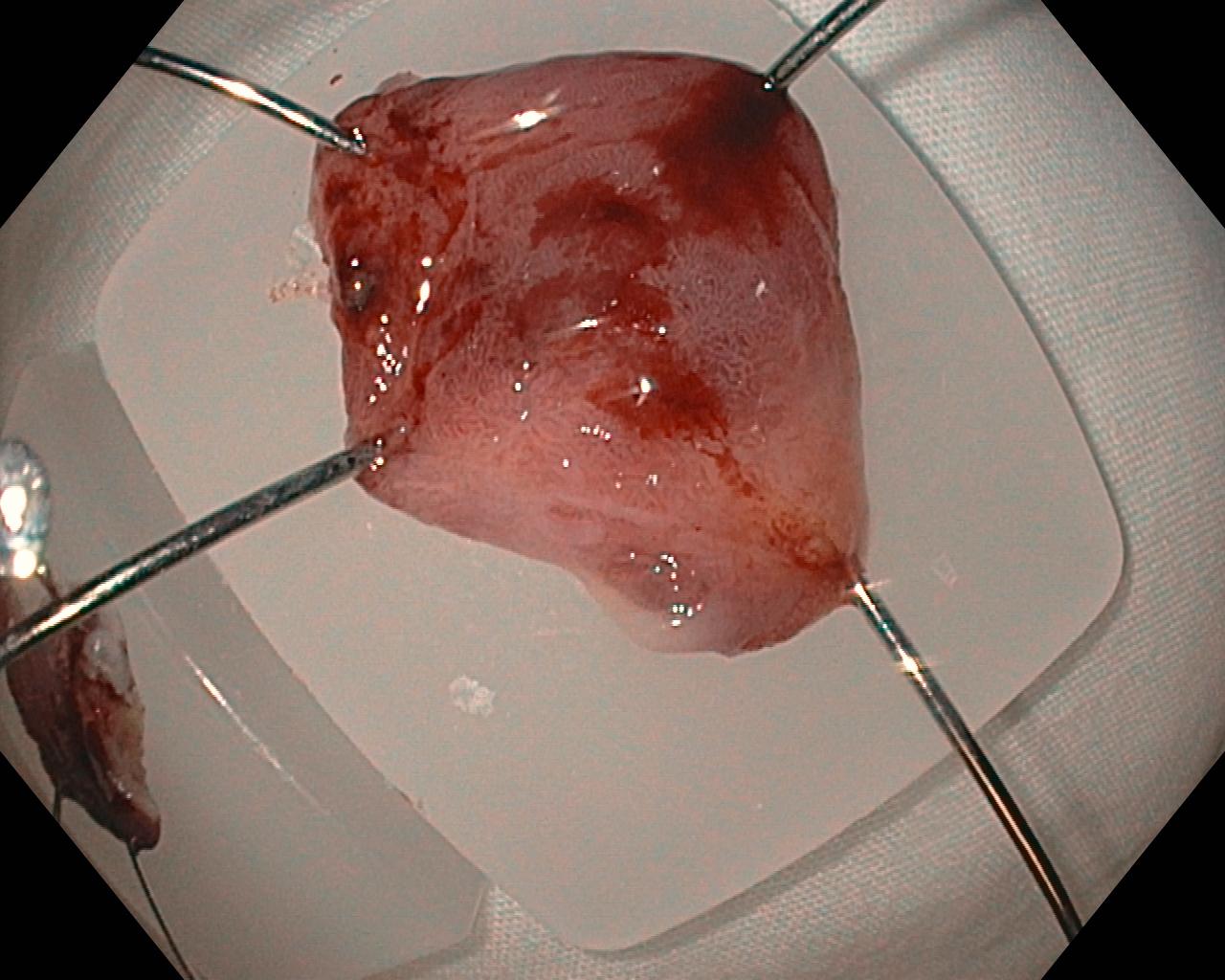
To facilitate coordination, it is helpful if the endoscopist indicates that the specimen was resected with curative intent and requests margin status and histologic features associated with curative resection, as noted earlier.
A general framework for processing biopsy specimens is provided in Table 1.1 .
| Technique | Comment |
|---|---|
| Formalin fixation | Routine processing of all alimentary tract biopsies; immediate immersion in fixative; permits immunohistochemistry and molecular analysis |
| Flow cytometry | Suspected hematologic malignancy; fresh tissue in sterile culture medium |
| Electron microscopy | Suspected poorly differentiated malignancy, infection (e.g., Whipple disease, microsporidiosis); immediate immersion in electron microscopy fixative |
| Electron microscopy fixative only | Suspected systemic mastocytosis for which plastic-embedded thick sections with toluidine blue staining may be used for identification of mast cells |
| Microbial culture | Suspected viral, fungal, or parasitic infection; sterile tissue |
| Biochemical analysis | Suspected metabolic deficiency (e.g., disaccharidase deficiency); frozen tissue |
| Cytogenetics ∗ | Suspected neoplasm (benign or malignant); fresh tissue in sterile culture medium |
| Cell culture ∗ | Suspected neoplasm (benign or malignant); fresh tissue in sterile culture medium |
Of the many types of fixatives used for human tissue, 10% buffered formalin remains the standard and is well suited for mucosal biopsies of the GI tract. It is inexpensive, harmless to the tissue even after long periods, and compatible with most of the stains commonly used for morphologic assessment. Hollende solution, B5, and Bouin fixative have been used for mucosal biopsies because of better preservation of nuclear morphology compared with formalin. However, the heavy metal content of these fixatives creates biohazard disposal problems that are greater than those of formaldehyde-based fixatives. These fixatives also interfere with isolation of nucleic acid from tissue; the search for substitute fixatives and new tissue processing techniques is an active area of scientific investigation.
On occasion, the formaldehyde in formalin may be irritating to the eyes and upper respiratory tract of laboratory personnel. The level at which formalin is considered carcinogenic is well above the level that causes sensory irritation, which has a threshold of 1.0 ppm. Accordingly, in pathology suites, proper ventilation should be used to maintain exposure below 1.0 ppm, the lowest concentration that may exert a cytotoxic effect in humans. , A workplace surveillance program for formalin exposure is recommended. Typical occupational exposure in endoscopy suites is exceedingly brief, so special ventilation is not usually required in that hospital area.
Alimentary tract biopsy specimens should be placed in a volume of formalin fixative that is at least 10 times greater than that of the tissue, and the fixative should surround the specimen completely. These parameters are usually easily met with small endoscopic tissue samples and even with those obtained by EMR, using small tubes of fixative solution. For routine processing, it is a common mistake to place specimens on saline-soaked gauze for delivery to the pathology suite, because severe drying may occur. Complete immersion of these biopsies in formalin should always occur at the bedside. Formaldehyde diffuses into tissue at a rate of approximately 1.0 mm per hour at room temperature. Therefore up to 1 hour is often needed to adequately fix a specimen with a diameter greater than 1.0 mm, and more time is needed for larger specimens. Controlled microwave fixation at 63° to 65°C can greatly speed the process and is useful for rapid processing of specimens.
Esophageal, gastric, and colonic mucosal biopsies do not require precise orientation before tissue processing and embedding. Until the mid-1980s, most peroral small intestinal biopsies were obtained by either a Crosby suction capsule or a Quinton hydraulic assembly. , These two methods were performed fluoroscopically and therefore did not permit direct visualization of the alimentary tract. Biopsies obtained by these methods were carefully oriented under a dissecting microscope before fixation and embedding. By the late 1980s, fluoroscopy was replaced by a suction capsule biopsy procedure in direct endoscopic biopsy of the small intestine. , Biopsies obtained by this technique are not usually oriented before immersion in fixative, processing, and embedding. Rather, microscopic examination of multiple tissue sections usually permits identification of portions of the small-intestinal mucosa that are well oriented and therefore can be assessed satisfactorily for tissue architecture.
In contrast, processing of an endoscopic polypectomy specimen in the pathology suite requires diligent effort. The size and surface configuration (bosselated or villiform) of the polyp should be noted, and the base of the polyp should be identified and described as to whether it is sessile or contains a cylindrical stalk. Regardless of the configuration of the stalk, the base of the polyp should always be inked. Ink and cautery artifact on a microscopic slide are valuable landmarks for locating the relevant resection margins. Small polyps (<1 cm in diameter) should be bisected along the vertical plane of the stalk so that the surgical margin is included. Both halves of the specimen can then be submitted in one cassette.
Section levels should be numbered consecutively; the first level is the one usually located closest to the middle of the polyp stalk. Large polyps (≥1 cm in diameter) may be sectioned differently if the polyp head is too wide to fit into a single cassette. First, the polyp is bisected along its long axis and fixed overnight in formalin. Once fixed, the sides of the polyp may be trimmed away from the stalk on a vertical axis and submitted in separate cassettes that are labeled accordingly. The middle of the polyp, including the base, is sectioned vertically and submitted in an appropriate number of cassettes. If a stalk is identified histologically, the status of the margins should be noted in the surgical pathology report.
If the polyp has been excised in a piecemeal fashion, the size, color, surface configuration (bosselated or villiform), and aggregate dimensions of the tissue fragments should be noted. It is important to record the number of tissue fragments received in the pathology suite.
GI lesions suspected of representing a lymphoproliferative process are usually submitted for histology but should also be processed for flow cytometry. Biopsy specimens intended for flow-cytometric analysis, such as gastric biopsies of a mass suspected of being lymphoma, or EUS-guided fine-needle aspiration (FNA) samples from concerning lymph nodes, should be placed in sterile culture medium and delivered as rapidly as possible to the flow cytometry laboratory. Ideally, this should occur within several hours, but storage of specimens at 4°C overnight is an acceptable alternative.
On receipt in the laboratory, the tissue specimen is disaggregated, and a cell suspension is prepared. Cocktails of fluorescently labeled antibodies appropriate to the diagnostic question are applied to the cell suspension. Current flow cytometry machines can analyze 5000 to 10,000 cells per second, measuring multiple wavelengths of laser-induced fluorescence simultaneously and thus permitting rapid and highly efficient analysis of cell populations. This technique cannot be performed on fixed tissue. It is therefore incumbent on the endoscopist to consider the possibility of a lymphoproliferative disorder at the time of endoscopy to ensure that tissue is preserved in a fresh state. Communication between the endoscopist and the pathologist before or immediately after the procedure increases the likelihood that the flow cytometry sample will be received and processed in a timely fashion.
For the rare instances in which electron microscopy of an alimentary tract biopsy is contemplated, tissue samples should be placed directly into the appropriate fixative, which usually consists of a mixture of paraformaldehyde and glutaraldehyde. Unlike formaldehyde-based fixatives, bifunctional glutaraldehyde fixatives penetrate only approximately 0.5 mm into the tissue. Therefore tissue fragments to be placed in fixative for subsequent electron microscopy should, ideally, measure less than 1.0 mm in maximal dimension. Indications for electron microscopy of endoscopic biopsy specimens are now largely limited to examination of unusual tumors. However, this technique is also helpful in cases of diarrhea of unknown cause in children and for detection of parasitic organisms in patients with acquired immunodeficiency syndrome (AIDS).
Become a Clinical Tree membership for Full access and enjoy Unlimited articles
If you are a member. Log in here